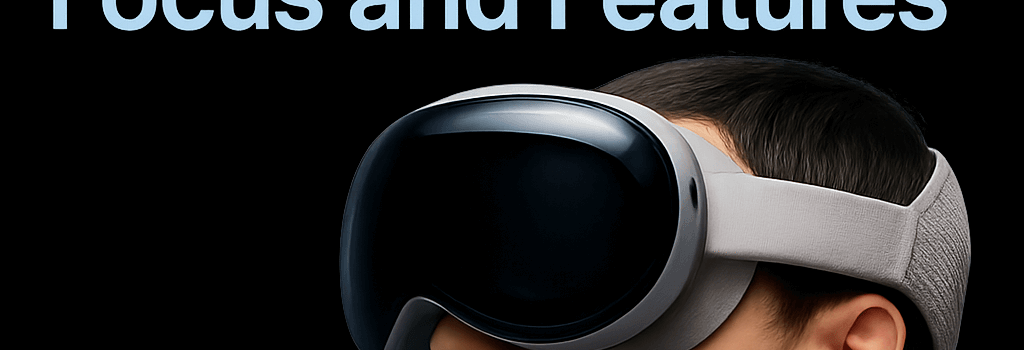visionOS 26 Enhances Apple’s Vision Pro: Focus and Features

Introduction
With the unveiling of visionOS 26 at Apple’s Worldwide Developers Conference (WWDC) on June 9, 2025, the company has signaled a strategic pivot from experimental features to practical enhancements tailored to how Vision Pro users interact with mixed reality. This update, representing a jump from visionOS 2 to 26 as part of a broader naming realignment across Apple platforms, is scheduled to arrive later this year. It introduces key improvements in multi-user synchronization, native 3D video playback, accessory support, widgets, and enterprise-grade APIs.
Major Features
- Multi-User Spatial Sync: Enables simultaneous content sharing among multiple headsets in the same room with sub-20 ms latency sync.
- Native 3D Video Playback: Support for standard glTF and USDZ formats at up to 8K@60 fps using H.265 and AV1 codecs.
- Six Degrees of Freedom (6DoF) Accessory Support: Adds compatibility for third-party controllers and design pens via USB-C and Bluetooth LE Audio.
- Spatial Widgets: Anchorable widgets in real-world coordinates, leveraging Apple’s SceneKit and RealityKit frameworks.
- Enterprise APIs: Team device sharing, Secure Enclave–backed content encryption, and Mobile Device Management (MDM) extensions.
Multi-User and Spatial Sync
visionOS 26 introduces peer-to-peer networking via Apple’s proprietary Ultra Wideband (UWB) protocols combined with Wi-Fi 6E, allowing two or more Vision Pro units to synchronize video playback or collaborative applications. Initial tests by developers show synchronization within 15–18 ms, a critical improvement for co-watching movies or collaborative CAD sessions.
3D Video Playback and Developer Tools
Until now, Vision Pro users relied on niche third-party tools to load externally sourced 3D videos. With visionOS 26, Apple has added native players supporting widespread formats such as USDZ, glTF, and FBX. Hardware-accelerated decoding leverages the M2 Max chip’s media engine with eight AV1 decoding cores, enabling smooth 8K playback at 60 fps. Developers can integrate playback APIs directly into RealityKit applications using the new AV3DKit framework.
Advanced Accessory Support
Responding to developer feedback, Apple has opened the accessory stack to 6DoF input devices. Standard HID profiles over USB-C and Bluetooth LE allow VR controllers and precision pens to function out of the box. Benchmarks reveal sub-5 ms end-to-end latency, making the Vision Pro competitive with established VR platforms for gaming and industrial design.
Widgets and Spatial User Interface
Widgets in visionOS go beyond iOS design by permitting absolute positioning within a user’s physical space. Anchoring uses SLAM-based environment mapping, storing anchor metadata via ARWorldMap files. Users can place a live calendar on a wall, a media control panel on their desk, or a virtual window into remote environments.
Performance and Hardware Pipeline
visionOS 26 includes under-the-hood optimizations that improve graphical throughput by 20% and reduce system jitter. Apple’s Unified Memory Architecture now dynamically allocates up to 32 GB for GPU tasks on M2 Ultra–powered developer kits. Thermal management improvements extend continuous high-load sessions by 30% before thermal throttling.
Enterprise Security and Deployment
The update adds Managed Apple IDs support and Secure Enclave enhancements for enterprise deployments. Organizations can now configure device sharing policies, enforce per-app VPN tunnels, and leverage Apple Business Manager for zero-touch enrollment. All pinned content can be encrypted with AES-256 and tied to the device’s hardware UID.
Developer Ecosystem and Open Standards
At WWDC 2025, Apple reaffirmed its commitment to OpenXR by releasing a beta OpenXR runtime for visionOS. Collaboration with Unity and Unreal Engine ensures developers can port existing VR titles with minimal code changes. Expert opinion suggests this move could accelerate third-party app availability by 50% in the next year.
Expert Opinions
“visionOS 26 is Apple’s most pragmatic update yet, addressing real-world developer and user needs while aligning with industry standards,” says Dr. Aisha Thompson, AR/VR researcher at MIT Media Lab.
Looking Ahead
While the Vision Pro’s premium price point limits mainstream adoption, visionOS 26 strengthens its position in professional and enterprise contexts. Rumors indicate that visionOS 27 may introduce low-power AR glasses compatibility and expanded AI-driven features, setting the stage for a more accessible mixed-reality future.
Conclusion
visionOS 26 marks a shift from experimental to essential, bringing Vision Pro’s capabilities in line with user expectations and industry benchmarks. By focusing on synchronization, native media support, accessory integration, and enterprise readiness, Apple is refining its mixed-reality offerings ahead of broader market expansion.